I probably could stop.
If I wanted.
Last time I told you about my adventures in Kent with the 28 species I have seen in the county, though it was 27 then, and 25 in just east Kent, but things change. I did intend to just do orchids in Kent.
But.
I bought a book, Harrap’s Orchids of UK and Ireland: A field and site guide (ISBN 139781408105719) and began to look at all the fabulous species that lay outside our county’s borders. In particular, there was a species that was only fund in one place in the UK, and whose total population was less than 200 plants: The Lindisfarne Helleborine.
I don’t know why I focused on that, but I did, perhaps for its rarity.
Anyway, the book gives information not just on the species of orchids, but as the sub-title suggests also is a site guide too. Now, I should point out that this book is now quite old and much of the information is out of date, I did use it in County Durham and Teesside a couple of years back, and the three sites mentioned in the book I visited, all lacked any orchid species.
Back to Kent, and the species that was giving me the most trouble was the Burnt (Tip), many of the sites in the county have been lost, and I did know roughly where the orchid could be found, but the reserve is large, and the orchid small. After several seasons searching, I decided in May 2014 to venture outside Kent to see this species.
I was given a hand drawn map and directions where to go from the centre of Glynde, so one fine spring morning, we drove to Lewis and to the village, parked beside the picturesque smith, and took the path up the down. Now, not all downs are created equal, and Mt Cabourne is a large down indeed with lots of up to get to the top. We huffed and puffed for over half an hour until we reached near the top, but the top was a wide flat area, and the map we had did not match what we saw with our own eyes.
After a couple of hours I realized what we thought were hills on the map were valleys and the opposite too, once that was clear, I looked over a shallow valley to a bank on the other side and I saw a pale pink flower.
 Could it be?
Could it be?Yes, it was the first of hundreds of Burnt Orchids we were to see, at a site where in good years several thousand spikes can be seen. And for a species in Kent where I know in the very best years were get just three plants.
 Happy, we walked down, but the Rubicon had been crossed, I had ventured out of the county in search of orchids, where would it lead?
Happy, we walked down, but the Rubicon had been crossed, I had ventured out of the county in search of orchids, where would it lead?It would lead to Northumberland.
We booked a holiday totally round the prospect of visiting Lindisfarne and seeing the Helleborine. Ten days. Nothing odd in that at all. No.
So, using the book as a guide as to be in the middle of the flowering period, we booked up a cabin beside Kielder Water, and would travel out most days looking for orchids.
What could go wrong?
Well, despite it being a warm and early season in Kent, it wasn’t in northern England, and in fact we would see no Lindisfarne Helleborine in flower on that visit. The site, however, is fabulous.
Going by the name of The Snook, a large area of dune slacks full of orchids and other plants was a delight, where Northern Marsh, Common Spotted, Early Marsh, Marsh Helleborines and Pyramidals all in flower and looking wonderful. Just no Helleborines.
Along the River Tyne, in places where heavy industry used to take place, possibly due to contamination by heavy metals, a sub-species of Dune Helleborine, the Tyne Helleborine can also be found, but again these were not to flower during our holiday. More on these in a minute.
But, just over the border in County Durham is an abandoned quarry, now turned into a nature reserve, in which grows what I think it the most attractive of all UK orchids. A bold claim I know, but then to see Dark red helleborines in the sunshine, with the colour combination of yellow and dark red is to be in the presence of beauty.
 The quarry is not signposted, and it took a visit to the local shop for directions, but once there, and the clamber down the side of the rockface by means of steep steps, so that once at the bottom, the grassed area is dotted with hundreds of orchid spikes.
The quarry is not signposted, and it took a visit to the local shop for directions, but once there, and the clamber down the side of the rockface by means of steep steps, so that once at the bottom, the grassed area is dotted with hundreds of orchid spikes. I was born in Norfolk and grew up in Suffolk, but my family remained there, so from time to time I would go back to visit, places, flowers or graves and so on. Thanks to the book, I found there was a reserve where Frog Orchids could be found. Situated outside a small village, but within sight of the church tower, the reserve is surrounded by a hedge. Inside it is an unimproved meadow, which is early spring is home to hundreds of Green Wing Orchids, some of which are of a very rare but fetching bi-colour variant.
I was born in Norfolk and grew up in Suffolk, but my family remained there, so from time to time I would go back to visit, places, flowers or graves and so on. Thanks to the book, I found there was a reserve where Frog Orchids could be found. Situated outside a small village, but within sight of the church tower, the reserve is surrounded by a hedge. Inside it is an unimproved meadow, which is early spring is home to hundreds of Green Wing Orchids, some of which are of a very rare but fetching bi-colour variant.  Returning at the end of May meant searching the reserve, not large but overgrown for an orchid I had not seen before. Could we find it? It took two hours, but the familiar basal leaves gave it away, and soon several spikes were found, some with red tinged flowers and others just green.
Returning at the end of May meant searching the reserve, not large but overgrown for an orchid I had not seen before. Could we find it? It took two hours, but the familiar basal leaves gave it away, and soon several spikes were found, some with red tinged flowers and others just green.  This is another former Kent species, and work is underway by KWT to reintroduce the species to the town at their last known location, but it is going to take many years of grazing before any flowering plants will be seen.
This is another former Kent species, and work is underway by KWT to reintroduce the species to the town at their last known location, but it is going to take many years of grazing before any flowering plants will be seen.
 In 2015, we returned to Northumberland, going two weeks later, just to be sure, and staying on the island to give us a chance to hunt the Snook all over. But, there’s always a but, the season was even later that in the previous years, and the pale yellow spike we found had its bud tightly closed. It was the same at the reserve high in the Tyne Valley, the Tynes also were nowhere near opening either.
In 2015, we returned to Northumberland, going two weeks later, just to be sure, and staying on the island to give us a chance to hunt the Snook all over. But, there’s always a but, the season was even later that in the previous years, and the pale yellow spike we found had its bud tightly closed. It was the same at the reserve high in the Tyne Valley, the Tynes also were nowhere near opening either. Darn it.
Darn it.We had a week in a cottage near to a Roman encampment, and then a trip to Scotland for three days, so two weeks after we had travelled up, we packed to return home. But.
 I had tweeted our bad luck and someone had messaged me to say the Lindisfarne Helleborines were open, and that there was another site along the Tyne where the Tynes were flowering too. We checked the tide times for getting to the island along the causeway, and it was in our favour, we could get across at eight, visit the orchid and get shots before getting back to the mainland before the tide closed the road, then drove to Newcastle, along the A69, stop at Wylam and looks for what we were told were hundreds of spikes.
I had tweeted our bad luck and someone had messaged me to say the Lindisfarne Helleborines were open, and that there was another site along the Tyne where the Tynes were flowering too. We checked the tide times for getting to the island along the causeway, and it was in our favour, we could get across at eight, visit the orchid and get shots before getting back to the mainland before the tide closed the road, then drove to Newcastle, along the A69, stop at Wylam and looks for what we were told were hundreds of spikes. The first part, getting to Lindisfarne went without a hitch. We parked and walked to the fenced area and already there were two fellow photographers who were getting their shots too. The orchid is a disappointment, sickly yellow with only a few flowers. Once pollinated it quickly dies to set seed, usually flowering for less than two weeks, so we were lucky.
The first part, getting to Lindisfarne went without a hitch. We parked and walked to the fenced area and already there were two fellow photographers who were getting their shots too. The orchid is a disappointment, sickly yellow with only a few flowers. Once pollinated it quickly dies to set seed, usually flowering for less than two weeks, so we were lucky. Since then, genetic sequencing has revealed the Lindisfarne Helleborine to be another sub-species of the Due, like the Tyne, so is no longer a separate species, but was when I saw it, and that’s all that matters!
Since then, genetic sequencing has revealed the Lindisfarne Helleborine to be another sub-species of the Due, like the Tyne, so is no longer a separate species, but was when I saw it, and that’s all that matters!As for the Tyne: parking was at the National Trust’s George Stephenson’s cottage, but all we knew was that somewhere on the north bank there were orchids. We walked and walked and walked, but found nothing, but then deep in a wooded copse, Jools shouted, and there were orchids. The Tyne has an extended lip, so looking for all the world like the southern Narrow-lipped helleborine. I don’t know about hundreds, but we found a good dozen.
 It had only taken two family holidays and four weeks to finally see the two species.
It had only taken two family holidays and four weeks to finally see the two species.Variation names and criteria are the bane of an orchidist, and frankly, too boring to mention normally, but Ophrys species have variants, they are usually worth seeing, though in Sean Cole and Mike Waller’s vegetive guide, they do away with vars altogether and just say that all such things are normal colour variations in a given species.
 That notwithstanding, news that there is a sizeable colony of yellow Bee Orchids at Rye Harbour just over the border meant I had to go and check. It took an hour, but on a new earthen food defence, first I saw regular Bees, and then, far more numerous, were the var. flavecens spikes. Dozens of them.
That notwithstanding, news that there is a sizeable colony of yellow Bee Orchids at Rye Harbour just over the border meant I had to go and check. It took an hour, but on a new earthen food defence, first I saw regular Bees, and then, far more numerous, were the var. flavecens spikes. Dozens of them. The warden explained that orchids are generally colonisers, and expected them to be crowded out in a few years, but quite why this colony as a ratio of about 10:1 in favour of the yellows is unclear.
The warden explained that orchids are generally colonisers, and expected them to be crowded out in a few years, but quite why this colony as a ratio of about 10:1 in favour of the yellows is unclear.Barton Broad is a closed RSPB reserve. Closed because it is a floating fen. You walk on years accumulation of dried reeds, and unless you know where to step, you could fall through. I went there having stumped up a lot of money for a charity to be one of three folks to be guided to see the diminutive Fen Orchid.
 There are several orchid species that are small, disappointing, hard to find, and the first one of these I really went to look for was the Fen.
There are several orchid species that are small, disappointing, hard to find, and the first one of these I really went to look for was the Fen. The orchids are green, small and with un-orchid-like flowers they do underwhelm, but the reserve itself is stunning, and is also home to a unique variation of the Early Marsh Orchid, a fine cream coloured var. gemmanda.
The orchids are green, small and with un-orchid-like flowers they do underwhelm, but the reserve itself is stunning, and is also home to a unique variation of the Early Marsh Orchid, a fine cream coloured var. gemmanda.  I did escape the broad having nearly fell through with literally my last step on the floating fen, but the warden saved me.
I did escape the broad having nearly fell through with literally my last step on the floating fen, but the warden saved me.In July 2018, I was lucky enough to see a colony of southern European tongue orchids that had been found in a field in Essex. The previous summer, a botanist had been doing a survey for a developer when he found something he thought unusual, posted a shot, had the ID confirmed, but then realized he had posted it on a public forum, so was removed. Someone had screenshotted it, and knowing the town the site was in the area of, spent three days triangulating the trees in the background of the shot until the colony was found.
 No one can be sure how the Greater Tongue orchid Serapias lingua came to be in a field in Essex, but the 70 or so spikes found indicated they had been there many years, undiscovered and just enjoying life. It has taken 5 years of battling the developer and local council, but in 2023 the site was saved and the non-native species are protected as naturalized.
No one can be sure how the Greater Tongue orchid Serapias lingua came to be in a field in Essex, but the 70 or so spikes found indicated they had been there many years, undiscovered and just enjoying life. It has taken 5 years of battling the developer and local council, but in 2023 the site was saved and the non-native species are protected as naturalized. Yay.
What constitutes wild and/or native orchids is a subject for debate, so the next site is Wakehurst Place in Sussex here they have, or rather had, two species of Hardy Orchids, one native and the other our friend the Greater Tongue Orchid. The other, Lax (or Loose) Flowered Orchid is only found in the Channel Islands wild in the UK, so a trip to Sussex to see their three spikes was a treat. I believe that in recent years, guides are refusing to say where the orchids are, and the Tongue have since failed to show.
Yay.
What constitutes wild and/or native orchids is a subject for debate, so the next site is Wakehurst Place in Sussex here they have, or rather had, two species of Hardy Orchids, one native and the other our friend the Greater Tongue Orchid. The other, Lax (or Loose) Flowered Orchid is only found in the Channel Islands wild in the UK, so a trip to Sussex to see their three spikes was a treat. I believe that in recent years, guides are refusing to say where the orchids are, and the Tongue have since failed to show.
 Which brings us to the Lady’s Slipper Orchid, and it’s curious history. Best to read Jon Dunn’s Orchid Summer book in which he describes the amazing survival story that the species has in this country, and the lengths people will go to “own” one or a piece of it. And in following up the question as to what constitutes a native or non-native plant.
Which brings us to the Lady’s Slipper Orchid, and it’s curious history. Best to read Jon Dunn’s Orchid Summer book in which he describes the amazing survival story that the species has in this country, and the lengths people will go to “own” one or a piece of it. And in following up the question as to what constitutes a native or non-native plant.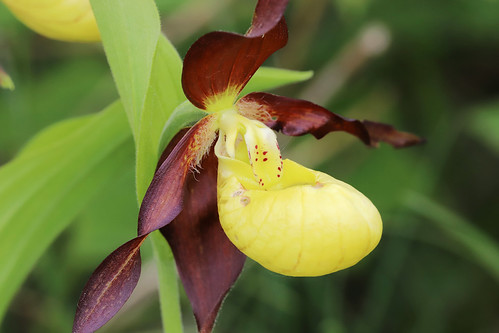 I was given the grid reference for a single plant on a lesser-known reserve in Lancashire. I drove for six hours, went straight to the site, walked round the reserve, into a walled paddock and there behind a tree was the twin spiked plant of the Lady’s Slipper. It was perfect. Just as well as the species fades quickly usually after just a week in flower, I had chosen well to go that week. And yet, the following autumn the plant was dug up and removed.
I was given the grid reference for a single plant on a lesser-known reserve in Lancashire. I drove for six hours, went straight to the site, walked round the reserve, into a walled paddock and there behind a tree was the twin spiked plant of the Lady’s Slipper. It was perfect. Just as well as the species fades quickly usually after just a week in flower, I had chosen well to go that week. And yet, the following autumn the plant was dug up and removed.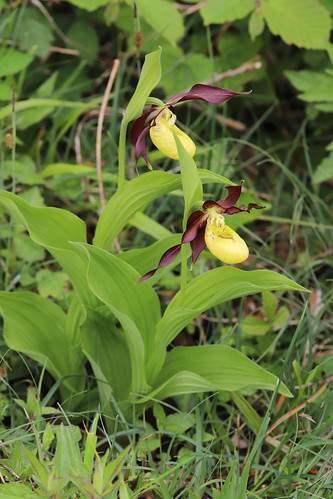 Genetic sequencing had sown it to be partly Continental in heritage. But with a program to grow UK native stock has been under way for some time, and soon the reserve will get it’s Lady’s Slippers back, but they will be placed on the limestone pavement where they should be, not in damp lowland where rings of copper were needed to prevent slug damage.
Genetic sequencing had sown it to be partly Continental in heritage. But with a program to grow UK native stock has been under way for some time, and soon the reserve will get it’s Lady’s Slippers back, but they will be placed on the limestone pavement where they should be, not in damp lowland where rings of copper were needed to prevent slug damage.On the way back from Lancashire, I diverted to Gloucestershire, where a friend was going to show me another new species, and a hybrid.
There are species, sub-species, variants and hybrids. Each hold fascination, but vars and hybrids exist in an orchid world of blurry lines and strong opinions. In the UK we have four Ophrys species, and in theory, each can hybridise with each other creating beautiful monsters. Most of the country just has Fly and Bee Orchids, only a couple of other counties has Early Spiders and only Kent has Late Spiders.
 On a down overlooking the Bristol Channel, in the remains of a small excavation, were two small spikes. It had taken us a good ten minutes to walk from the car in the centre of the common, then ten more while my friend tried to triangulate the right place, but here are some of the fabulous Bee x Fly, Ophrys x pietschii.
On a down overlooking the Bristol Channel, in the remains of a small excavation, were two small spikes. It had taken us a good ten minutes to walk from the car in the centre of the common, then ten more while my friend tried to triangulate the right place, but here are some of the fabulous Bee x Fly, Ophrys x pietschii. Sword leaved helleborines have been extinct in Kent for over 30 years, rumours surface from time to time that one or more has been found, but I have seen no evidence. So, after seeing the hybrids, we drove to a larger down, parked and walked down slips that seemed impossibly steep, and I knew that with each step forward I was going to have to walk back up too. At the foot of the slope there were three spikes, two in flower, of the SLH, similar to our White Helleborine, but different; many more flowers and most open showing their yellow throats. It was hard enough to get shots without sliding further down, but once had our shots, then came the long hard climb. Step by step.
But at least there was a very good ice cream parlour on the green when we reached the top.
Sword leaved helleborines have been extinct in Kent for over 30 years, rumours surface from time to time that one or more has been found, but I have seen no evidence. So, after seeing the hybrids, we drove to a larger down, parked and walked down slips that seemed impossibly steep, and I knew that with each step forward I was going to have to walk back up too. At the foot of the slope there were three spikes, two in flower, of the SLH, similar to our White Helleborine, but different; many more flowers and most open showing their yellow throats. It was hard enough to get shots without sliding further down, but once had our shots, then came the long hard climb. Step by step.
But at least there was a very good ice cream parlour on the green when we reached the top. Also in 2014, but again in 2022, I visited two sites in the Cotswolds, one for the Military Orchid, and one for the hybrid between the Lady and Monkey Orchids, all being Orchis species and oh how they like to hybridise.
Also in 2014, but again in 2022, I visited two sites in the Cotswolds, one for the Military Orchid, and one for the hybrid between the Lady and Monkey Orchids, all being Orchis species and oh how they like to hybridise. But more of that in a minute.
But more of that in a minute.The Military Orchid was once found in Kent, its last site I think was in a quarry in Dartford, but that colony has long been lost and the site developed as is the case in many sites in that area. The site in Buckinghamshire is another that deserves to be read, and Jon Dunn again describes it in his book Orchid Summer. Thought to be extinct, a colony was found in a woodland clearing, and it is that colony that endures and thrives to this day. The clearing also has Fly, White Helleborine and spikes of Broad leaved too, all to delight the eye and orchidist sensibilities.
 A half hour drive away, high on a slope overlooking the Thames is another reserve where Monkey Orchids can be found. What happened next is subject to much conjecture, but as gene sequencing has been done on the Lady Orchids now found there, and once again these are of Continental origin, these Madame Orchidee did not get onto this slope by accident, and yet, here they are.
A half hour drive away, high on a slope overlooking the Thames is another reserve where Monkey Orchids can be found. What happened next is subject to much conjecture, but as gene sequencing has been done on the Lady Orchids now found there, and once again these are of Continental origin, these Madame Orchidee did not get onto this slope by accident, and yet, here they are. And in Orchis species, like Dachts, when they hybrise they can produce infertile, fertile or hyper-fertile offspring, just depends on the parent species.
Here in Oxfordshire, they have produced the classic hybrid swam, with dozens of hybrids outnumbering and towering over both parent species. People and orchidists go to see the hybrids, but really it is the rare parent plants, and the Monkey in particular, we should care far more about. There are just three other sites in all of the UK for Monkey, two in Kent and a single plant found in a large field in Sussex two years ago, it has reappeared in the two seasons since.
And in Orchis species, like Dachts, when they hybrise they can produce infertile, fertile or hyper-fertile offspring, just depends on the parent species.
Here in Oxfordshire, they have produced the classic hybrid swam, with dozens of hybrids outnumbering and towering over both parent species. People and orchidists go to see the hybrids, but really it is the rare parent plants, and the Monkey in particular, we should care far more about. There are just three other sites in all of the UK for Monkey, two in Kent and a single plant found in a large field in Sussex two years ago, it has reappeared in the two seasons since.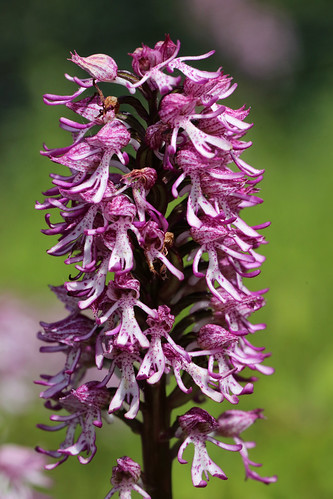 The Monkeys in Oxfordshire seem to be different, have a lilac tinge to them, but the good news is that they are thriving, and on my most recent visit in 2022, numbers had reached double figures with one plant even found on the road outside the reserve.
The Monkeys in Oxfordshire seem to be different, have a lilac tinge to them, but the good news is that they are thriving, and on my most recent visit in 2022, numbers had reached double figures with one plant even found on the road outside the reserve.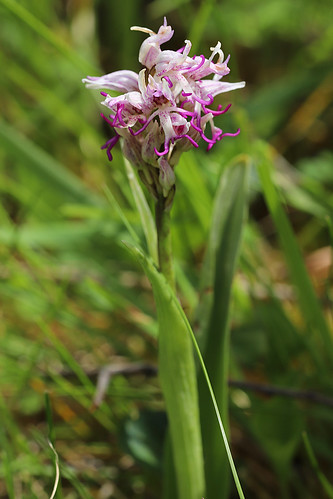 Good news indeed.
Good news indeed.So to 2022, and the annual family holiday, this time to north Wales. Anywhere you’d like to go? I was asked. Well, the Gower. Which is south Wales, not very near north Wales, but as it turned out, doable.
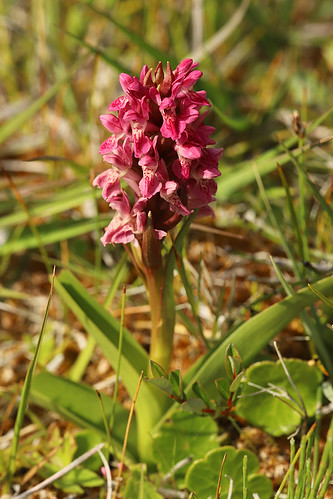 There is a reserve there, Kenfig, that had some fine bright-coloured variants of Early Marsh which we don’t get in Kent, so that would be nine and were my primary target. There was also, at the time, the only western colony of Fen Orchids. The Norfolk ones have pointed leaves and the Welsh ones have rounded leaves, but as we were there.
South Wales was something of a former industrial wasteland until we got onto the Gower, and then the open vistas, broad sandy beaches made it very nice indeed. Kenfig is not well signposted, but I had the postcode and the satnav, so we found it, paid for parking. And as usual had to dodge the dogs and their carefree owners letting the mutts run of the lead. In a nature reserve. Don’t get me started.
There is a reserve there, Kenfig, that had some fine bright-coloured variants of Early Marsh which we don’t get in Kent, so that would be nine and were my primary target. There was also, at the time, the only western colony of Fen Orchids. The Norfolk ones have pointed leaves and the Welsh ones have rounded leaves, but as we were there.
South Wales was something of a former industrial wasteland until we got onto the Gower, and then the open vistas, broad sandy beaches made it very nice indeed. Kenfig is not well signposted, but I had the postcode and the satnav, so we found it, paid for parking. And as usual had to dodge the dogs and their carefree owners letting the mutts run of the lead. In a nature reserve. Don’t get me started. I did have the grid reference for the Fen Orchids, remember these are tiny and green, so we followed the phone pointing us in the right direction. 800m. 500m. 100m. And rising in front of us were the large dunes, but in front, growing in deliberately disturbed ground where rosettes of Marsh Helleborines, and if you looked carefully, the Fen Orchids, two of which were in flower, one marked by a wonky stick, just so you could find it.
I did have the grid reference for the Fen Orchids, remember these are tiny and green, so we followed the phone pointing us in the right direction. 800m. 500m. 100m. And rising in front of us were the large dunes, but in front, growing in deliberately disturbed ground where rosettes of Marsh Helleborines, and if you looked carefully, the Fen Orchids, two of which were in flower, one marked by a wonky stick, just so you could find it. I had already been underwhelmed in Norfolk by these, so was happy to get shots, but on the walk out and back, encountered three different variants of the Early Marsh, including this fine var. coccinea, as well as the usual blush pink and some nice pure white ones. And some hybrids just to make life even more complicated.
Once in their life, every orchidist makes the pilgrimage to either the Cotswolds or Gloucestershire to see the rare Red Helleborine at least once. This is a different species from the Dark Red as previously spoken about in Durham, an altogether more weedy, fragile and picky orchid.
I had already been underwhelmed in Norfolk by these, so was happy to get shots, but on the walk out and back, encountered three different variants of the Early Marsh, including this fine var. coccinea, as well as the usual blush pink and some nice pure white ones. And some hybrids just to make life even more complicated.
Once in their life, every orchidist makes the pilgrimage to either the Cotswolds or Gloucestershire to see the rare Red Helleborine at least once. This is a different species from the Dark Red as previously spoken about in Durham, an altogether more weedy, fragile and picky orchid. The Red Helleborine grows in ancient woods, in thin, unfertile soil. Its never been common in England, but is now very rare, with just two or three viable sites and some years a single plant will flower. And the soil is so thin and easily disturbed, at the Cotswold site it is protected by not one, but two high chain linked fences, and we orchidists are only granted access to the gap between the two fences, not into the glad itself, so the plant and habitat is not damaged further.
The Red Helleborine grows in ancient woods, in thin, unfertile soil. Its never been common in England, but is now very rare, with just two or three viable sites and some years a single plant will flower. And the soil is so thin and easily disturbed, at the Cotswold site it is protected by not one, but two high chain linked fences, and we orchidists are only granted access to the gap between the two fences, not into the glad itself, so the plant and habitat is not damaged further.No willowy, weedy plant was as photographed as much as this one, with several visits arranged by the HOS that day, and me driving from Kent to the site, take shots and drive back in time to pick up my wife from work.
Red Helleborine refuses to be cultivated, so it cannot be introduced, so any new sighting happened naturally. In France and elsewhere they grow like weeds, but not here. This is another possible former Kent species, with a claimed sighting from nearly a century ago the best chance.
The last few UK species means lots of trips out just to see a single or handful of plants. I plan to see each species once, and that it, concentrate on Kent only, but for now, there are two more species in the 2022 season to see, and these are late ones, and as they were both flowering at the same time, I could see one on the way to Wales. Again.
 The Sword Leaved Helleborine looks very similar to the Tynes we saw earlier, but is a separate species, and was once found in several places in Kent, including the last known site near to Barham three decades ago. I did lead a search for it, but the wood had been badly managed, the canopy too full to allow the dappled sunlight the orchid likes, so none found. But in Surrey, just off the M25, I waited in a woodland car park for a man to come and show me his orchids.
Not his orchids, but the local expert.
The Sword Leaved Helleborine looks very similar to the Tynes we saw earlier, but is a separate species, and was once found in several places in Kent, including the last known site near to Barham three decades ago. I did lead a search for it, but the wood had been badly managed, the canopy too full to allow the dappled sunlight the orchid likes, so none found. But in Surrey, just off the M25, I waited in a woodland car park for a man to come and show me his orchids.
Not his orchids, but the local expert. And just a hundred yards into the wood, scattered among the widely spaced trees, were yet more weedy Helleborines, but these one like they had their tongues hanging out. I get my shot, and one of a possible hybrid with BLH nearby, but that was never confirmed.
And just a hundred yards into the wood, scattered among the widely spaced trees, were yet more weedy Helleborines, but these one like they had their tongues hanging out. I get my shot, and one of a possible hybrid with BLH nearby, but that was never confirmed.  And so on to Wales, four more hours to a hotel. Then two more hours in the morning to the coast where Irish Lady’s Tresses had been found two years before. These are mainly an American species, but as the name suggests, found also in Ireland, and also on some Scottish islands. And now Wales.
And so on to Wales, four more hours to a hotel. Then two more hours in the morning to the coast where Irish Lady’s Tresses had been found two years before. These are mainly an American species, but as the name suggests, found also in Ireland, and also on some Scottish islands. And now Wales. This was another meeting arranged by the HOS, so the devout arrived from all over the country, driving down a rough lane to a small car park where we were greeted, and just a few hundred yards away in a fenced area were the 27 spikes of the orchid. Larger, more robust than our Autumn Lady’s Tresses, but worth the trip up from Kent to see. Not all would agree, as I had the M6, M1 and M25 to battle to get home that evening so to go to work the next day.
This was another meeting arranged by the HOS, so the devout arrived from all over the country, driving down a rough lane to a small car park where we were greeted, and just a few hundred yards away in a fenced area were the 27 spikes of the orchid. Larger, more robust than our Autumn Lady’s Tresses, but worth the trip up from Kent to see. Not all would agree, as I had the M6, M1 and M25 to battle to get home that evening so to go to work the next day.  But two new species ticked off the list.
But two new species ticked off the list.Which brings us to 2023, and the little buggers.
But first, tales of a Giant.
The Giant Orchid is not that big. Not as big as you would imagine it would be with that name, and the truth is, the species has marched across France, Holland and Belgium and has now reached their North Sea coasts. So it was, we have been expecting the species to appear, probably in Kent or Sussex for a few years now. But it popped up in Oxfordshire instead.
 The Giant is related to the Lizard Orchid, though not as large as its reptilian cousin, and I had seen the species on Rhodes last year. It appears there and elsewhere when Beeflies are on the wing, so would be among the first orchid species to flower here.
The Giant is related to the Lizard Orchid, though not as large as its reptilian cousin, and I had seen the species on Rhodes last year. It appears there and elsewhere when Beeflies are on the wing, so would be among the first orchid species to flower here.And so it was.
The HOS offered a chance to visit the site, so I replied, and one damp and cold weekend at the end of March drove round the M25 and M4 into Oxfordshire, to arrive at a village car park where folks from all over the country were gathering.
Bill temple of the Society greeted us, and being local knew the history of the plants on the site, and that went back at least 15 years after one or two plants appeared, but seem to have been dug up. A few years later they re-appeared, possibly from seeds from those first plants.
The site is a steep former railway embankment, and was as steep as any down I have been on. A short walk out of the village brought us to the place, and two spikes could be seen halfway down. I tried to go down and then up, all was going well and I fell when I lost my footing, and ended up in a bramble patch having lost my glasses, covered in scratches. The treads on my boots were full of mud, I could get no grip, so in the end, hauled myself up using a loaned walking pole. On the way up I grabbed a few shots of one of the plants and made my way home, bloodied and bruised.
By now we are used to small and diminutive orchids, but the three I would be seeing on late May weekend were among the most uninspiring, and one is the smallest of the small.
I booked a photography weekend, paid quite a bit, but supporting a small business and all that. Drove up to Lancashire on a Friday afternoon, a Friday afternoon of a bank holiday weekend. Not my cleverest idea, and the journey from Stafford to Carnforth took four hours, arriving at my hotel just as it was getting dark and grabbing a place in the restaurant.
Next morning, I was up before the larks to drive to a reserve to meet with Mark. He had slept in the reserve car park, so once he was ready, we walked out onto the reserve and into the muddy bog.
The Coralroot Orchid is tiny. Hard to find, and as it grows in unpleasant bogs it can be a challenge to find and photograph. Even with grid references taken from previous years, it took half an hour to find the first spike, with two branches with flowers at each end, some 3 inches high. I say branches, but you know what I mean.
And hour’s more searching revealed three more plants, all tiny. So, we gave up, were walking along the boardwalk when something caught my eye. Something orchid-shaped. Mark, look at that, is that another?
 Growing right next to the boardwalk was the largest spike of Coralroot Vinny had seen, two more were growing in its shadow, this was a mighty oak compared to the twigs we had seen earlier, a spike so large I had seen it from walking at normal speed.
Growing right next to the boardwalk was the largest spike of Coralroot Vinny had seen, two more were growing in its shadow, this was a mighty oak compared to the twigs we had seen earlier, a spike so large I had seen it from walking at normal speed.An hour’s drive away was the next species. The Common Twayblade grows all over the UK, grows in meadows, on downs, in woods. Can be up to two feet high, is plain green, easy to overlook when growing among its more showy cousins. The Lesser Twayblade is something altogether more understated.
 On a high moor, like many others we had passed by on the drive, we stopped. Climbed a dry stone wall, though nesting Lapwings and their scampering chicks which were all legs and fluff, and out onto the wily, windy moor. The orchid grows under clumps of heather, is small and red.
On a high moor, like many others we had passed by on the drive, we stopped. Climbed a dry stone wall, though nesting Lapwings and their scampering chicks which were all legs and fluff, and out onto the wily, windy moor. The orchid grows under clumps of heather, is small and red.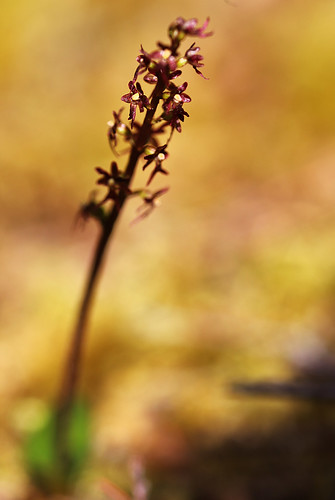 How small I hear you ask.
How small I hear you ask.About an inch, maybe two.
Without Mark I would never have spotted it, the small red and green spike looks all the world like a dried heather branch or some grass. But is an orchid. I even got to see it being pollenated by a tiny fly.
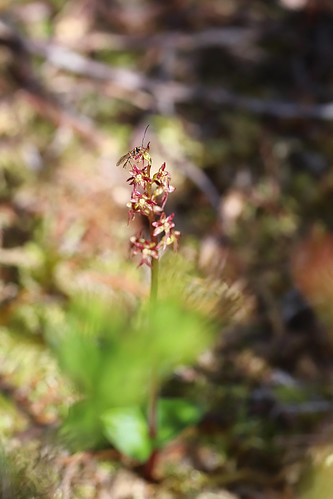 It was the only spike we found, was a bugger to photograph, but I had seen one.
It was the only spike we found, was a bugger to photograph, but I had seen one.That left one last species for the day. Some orchids have grand names, matching their beauty or size, but some it seemed botanist lacked imagination, so this was the Small White Orchid.
This is an orchid of northern climes, found all round and in the artic, and in northern England and Scotland, but is not common. This site in England is known, but not by many, and does involve, it seems, driving through someone’s front garden to get to the unmarked reserve and its car park.
 Above us was the fell, and down its flanks several slips had occurred, and on just one of them, the orchids can be found.
Above us was the fell, and down its flanks several slips had occurred, and on just one of them, the orchids can be found. Sadly for me, we were early, or the season late, so found only spikes in bud, but is probably the best I will see. I take shots of the one nearest flowering, and that was that.
Next day we drove into Yorkshire to a garden centre where they are looking after some of the pure blood native Lady’s Slipper Orchids. The clump nearest the path was already faded in the sun, but with permission we slipped under the ropes to see the spikes at the edge of the wood, where clumps with up to 22 spikes were perfectly in flower. It is hoped that some will be reintroduced, but due to the sickness of orchidmania, probably will need to be protected.
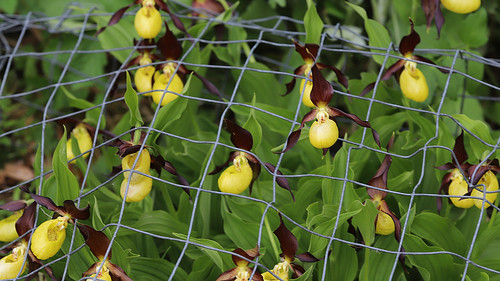 Also here were possibly the most contentious of the Spotted/Marsh Orchids, the Pugsley. I think we were early, and those at the site had been mis-labelled previous years, we certainly didn’t see one. This is also called the Narrow Lipped Marsh Orchid, and has certain features that separate it from Southern Marsh. It seems their stronghold is north Wales. If only I had known. Gene sequencing is apparently proving the Norfolk population not to be Pugsleys at all, though I’m sure some would argue.
Also here were possibly the most contentious of the Spotted/Marsh Orchids, the Pugsley. I think we were early, and those at the site had been mis-labelled previous years, we certainly didn’t see one. This is also called the Narrow Lipped Marsh Orchid, and has certain features that separate it from Southern Marsh. It seems their stronghold is north Wales. If only I had known. Gene sequencing is apparently proving the Norfolk population not to be Pugsleys at all, though I’m sure some would argue.And so to the final species of this presentation. A Fen is alkali, and so a bog is acid. Fen Orchids as we have seen are found in Norfolk and two sites in Wales, while Bog Orchids are even harder to find, more scarce, and their last stronghold in England is in the New Forest.
 One Sunday we left home at five to get to the Forest by eight, at least traffic is light at that time, so to meet a guy outside a pub to show us where to park a short drive away. As we walked through the ferns of the drier parts of the bog, mist lingered in the boughs of the nearby trees. The ground fell away and got wetter, until we came to the bog.
One Sunday we left home at five to get to the Forest by eight, at least traffic is light at that time, so to meet a guy outside a pub to show us where to park a short drive away. As we walked through the ferns of the drier parts of the bog, mist lingered in the boughs of the nearby trees. The ground fell away and got wetter, until we came to the bog. And my friend pointed, and there was a thicker stem, a slightly paler green in colour, maybe four inches tall, and this was the Bog Orchid. And in my friends experience, this was by some margin the largest spike he had seen.
And my friend pointed, and there was a thicker stem, a slightly paler green in colour, maybe four inches tall, and this was the Bog Orchid. And in my friends experience, this was by some margin the largest spike he had seen.I did manage to nearly fall over, lose my shoe and be soaked to the skin from the knees down, and declined the chance to see more, instead we climbed in the car and dove home, back by two and ready for a brew and some dry clothes.
There are two or so more species to see: Creeping Lady’s Tresses which are a Scottish species, apart from a colony in Norfolk which travelled south when some pine trees were transplanted to an estate, and there is the Irish Marsh Orchid, which as its name suggests needs a trip to the Emerald Isle. There is also the Dense Flowered Orchid there, but I saw that on Rhodes in 2022, so I think I can skip that.

No comments:
Post a Comment